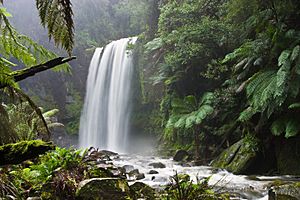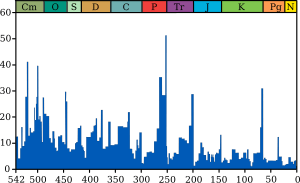Conservation biology facts for kids

Conservation biology is a science that studies Earth's amazing variety of life, called biodiversity. Its main goal is to protect species and their homes from disappearing too quickly because of human actions. It's a mix of different subjects like biology, physical science, social studies, and economics. Because living systems around the world are disappearing fast, conservation biology is often called a "Discipline with a deadline." It looks at how small groups of rare species can survive and grow. This field uses science to help keep genes, groups of living things, species, and ecosystems safe.
In the 1800s, people in the United Kingdom and the United States started protecting natural areas. Important figures like John Muir and Theodore Roosevelt led these efforts. By the mid-1900s, people began focusing on protecting individual species, like big cats in South America. By the 1970s, many plans were made to protect specific species, especially in the United States with the Endangered Species Act. The Society for Conservation Biology is a worldwide group of experts who work to improve the science of protecting Earth's biodiversity.
Contents
Why is Biodiversity Threatened?
Conservation biologists look at what happened in the past to understand why species are disappearing today. Scientists generally agree that Earth has had five big mass extinction events in its history. These happened millions of years ago.
Right now, Earth is going through what scientists call the Holocene Mass Extinction. This means an incredibly high number of species are disappearing. Humans have changed Earth's ecosystems so much in the last 10,000 years that it's hard to count how many species we've lost. Things like cutting down forests, destroying coral reefs, and filling wetlands are happening much faster than scientists can study them. A report by the World Wide Fund for Nature says that we are using Earth's natural resources faster than the planet can replace them. We would need 1.5 Earths to support our current demands!
Watching the Threats

There is a lot of evidence and shocking statistics showing that we are truly in the sixth major extinction event. It is happening at a speed never seen before. For example, about two-thirds of all large mammal groups and half of all mammal species weighing over 44 kg (97 lbs) have disappeared in the last 50,000 years. A study on amphibians shows they are disappearing faster than any other vertebrate group. Over 32% of all surviving amphibian species are at risk of extinction. Since the mid-1980s, the actual rate of extinction has been more than 211 times faster than what we see in the fossil record.
The same trend is happening with other animal groups. For instance, 23% of all mammals and 12% of all birds are on the "Red List" by the International Union for Conservation of Nature. This means they are also threatened with extinction. There are also big worries about other groups that don't get as much attention as popular animals. These include fungi, lichen, plants, and insects, which make up most of Earth's biodiversity. Protecting insects is super important for conservation biology. Insects are incredibly valuable to the global ecosystem because they weigh more than all other groups combined. However, people often don't like insects, which makes it harder to protect them.
It's even more complicated because most of Earth's species haven't even been discovered or studied yet. The IUCN found that 23% of vertebrates, 53% of invertebrates, and 70% of plants that have been studied are listed as endangered or threatened.
Many threats to biodiversity, like diseases and climate change, are now reaching beyond the borders of protected areas. This means even places like Yellowstone National Park are not fully safe. Climate change is a big concern because species disappearing can lead to more carbon dioxide being released into the air.
Earth's ecosystems store and move huge amounts of carbon. This helps control the global atmosphere. If we don't stop species from disappearing, more greenhouse gases will be released. Worldwide, the effects of global warming are a huge threat to biodiversity. A 2004 study estimated that 15% to 37% of all species could disappear by 2050.
Human activities are linked to almost every part of the current wave of extinctions.
Some of the biggest threats to biodiversity and ecosystems include: climate change, large-scale agriculture, deforestation, too much grazing by animals, slash-and-burn farming, city growth, and using pesticides. However, this doesn't mean these human activities *have* to cause harm. With good conservation plans, humans can live alongside nature.
How Conservation Works
Measuring How Fast Species Disappear
Scientists measure how fast species are disappearing in many ways. They look at fossil records, how fast habitats are lost, and other things like how biodiversity changes when habitats shrink. The natural "background extinction rate" is estimated to be about 1 species every few years. The current global extinction rate is about 100,000 times higher than this natural rate.
Planning for Conservation
Systematic Conservation Planning is a good way to find the best places and methods to protect the most important biodiversity. It involves six main steps:
- Gather information about the living things in the area you want to protect.
- Decide what you want to achieve with conservation in that area.
- Look at the protected areas that already exist.
- Choose more areas that need protection.
- Start doing the conservation work.
- Keep protecting the important parts of these areas.
Conservation biologists often use GIS (mapping software) to help them make these decisions.
What to Protect First: Ecosystems, Biodiversity, and People's Views

Most conservation scientists agree that it's important to keep biodiversity strong. However, they sometimes debate how to decide what's most important to protect: genes, species, or ecosystems. While many focus on "biodiversity hotspots" (areas with many different species), some scientists and groups like The Nature Conservancy think it's better to invest in "biodiversity coldspots." These might not have as many species but are still very important and might be easier to protect.
History of Conservation
The ideas behind conservation biology come from old spiritual beliefs, like those in Taoism, Shinto, Hinduism, Islam, and Buddhism. In the West, concerns about humans harming nature can be traced back to ancient thinkers like Plato. But modern conservation biology really started in the late 1700s in England and Scotland. People like James Burnett, Lord Monboddo talked about "preserving nature." Much of this early thinking was connected to Christian beliefs. By the early 1800s, scientists like Von Humboldt and Charles Darwin studied how species relate to their environments, but they didn't focus on actual conservation.
The word conservation became common in the late 1800s. It meant managing natural resources like wood, fish, game, soil, and minerals, often for economic reasons. It also meant protecting forests, wildlife, parks, and wild areas. Western Europe, especially the British Empire, made a lot of progress in conservation in the 1800s. The United States also started making big contributions. Thinkers like Henry David Thoreau inspired efforts. The United States Congress passed the Forest Act of 1891. John Muir started the Sierra Club in 1895. The New York Zoological Society was founded in 1895. And Theodore Roosevelt created many national forests and preserves from 1901 to 1909.
In the early 1900s, the New York Zoological Society helped develop ideas for creating special preserves for certain species. They also did studies to find the best places for conservation.
By the early 1970s, governments and international groups became more active in protecting biodiversity. The United Nations started a program in 1972 to protect places of great cultural or natural importance. The United States was the first country to pass strong laws for biological conservation, like the Endangered Species Act (1966) and the National Environmental Policy Act (1970). These laws provided money and protection for large habitats and threatened species research.
In 1980, the "urban conservation" movement started. This movement focused on protecting nature in cities. It began in Birmingham, UK, and quickly spread to other cities. At first, this idea seemed unusual, but now it's a common belief that conservation is connected to all human activities. A lot of research now focuses on urban conservation biology.
By 1992, most countries agreed to the principles of biodiversity conservation through the Convention on Biological Diversity. After this, many countries started Biodiversity Action Plans to find and protect threatened species and their habitats within their own borders.
Since 2000, the idea of "landscape scale conservation" has become very popular. This means focusing less on protecting just one species or one type of habitat. Instead, most conservationists now support an "ecosystem approach," which looks at the whole natural system.
The science of ecology has helped us understand how the biosphere works. This means understanding the complex connections between humans, other species, and the physical environment. Also, the growing human population, along with farming, industry, and pollution, has shown how easily these natural connections can be broken.
Images for kids
-
White gyrfalcons drawn by John James Audubon
-
Roosevelt and Muir on Glacier Point in Yosemite National Park
See also
 In Spanish: Biología de la conservación para niños
In Spanish: Biología de la conservación para niños







